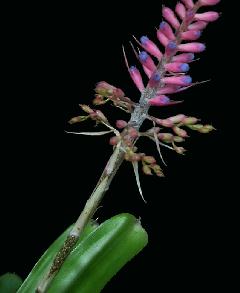
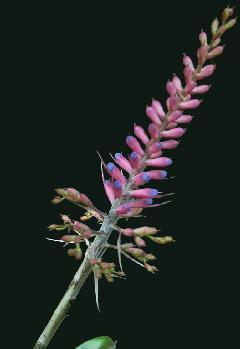
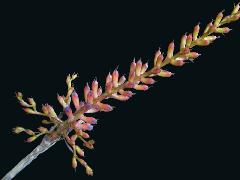
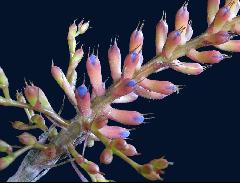
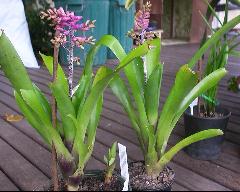
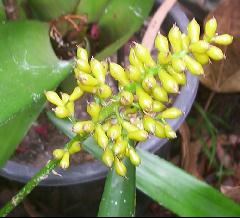
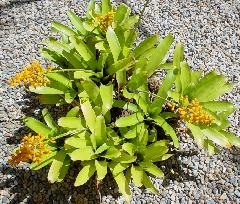
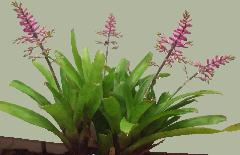
Derek Butcher has also tackled the problem of Aechmea gracilis in Australia, his records on this problem follow:
"There are three sizes - big, medium, and large. Of the large version there are two forms commonly called Qld form and NSW form.
A.gracilis has never been in Australia even though I have tried to get seed. It is in Florida but there nobody cares about its rarity.
If it were in Australia it WOULD get recognition!
Some time back, Harry Luther got fed up with Peter Franklin and my badgering and went down to Brazil to collect the true species from the wild."
Aechmea gracilis Lindman, Svensk. Akad. Handl. 24(8): 30, pI. 6, figs. 10-16. 1891.
Desc from S&D
Plant propagating by short, stout rhizomes, flowering 3-5 dm high. Leaves 10-15 in a sub cylindric rosette, suberect, 5-7 dm long; Sheaths elliptic, ca 1 dm long, tinged with purple; Blades ligulate, broadly rounded and apiculate, 3-4 cm wide, laxly and minutely serrate or subentire, pale beneath and sometimes banded. Scape erect, slender; Scape-bracts narrowly lanceolate, acute, entire, membranaceous.
Inflorescence simple or with a few 2-3-flowered branches at base, sub pyramidal or ovoid, 5-6 cm long, glabrous.
Floral bracts ovate, attenuate to a slender spine, entire, red, the lower 10-15 mm long; Flowers sessile, spreading, 20-25 mm long.
Sepals asymmetric, 6-7 mm long without the slender 3-5 mm terminal spine, connate to 3 mm; Petals ligulate, obtuse, 14-16 mm long, pale blue with apex darker, bearing 2 fimbriate scales at base; Stamens included;
Ovary sub cylindric, epigynous tube large; placentae central; ovules obtuse.
Type. Mosen 3707 (holotype, S; photo GH), Morro do Curupira, Sororocaba, Santos, Sao Paulo, Brazil, 30 Mar 1875.
Distribution. Epiphytic in forest, from near sea level to 1000 m alt, (Guanabara) to Santa Catarina, Brazil.
BRAZIL. (Guanabara): Rio de Janeiro, 25 Mar 1953, Reitz 5673 in part (HBR). Sao Paulo: Iguape, Santos, 5 Oct 1894, Loefgren & Edwall in Com. G. & G. de S. Paulo 2719 (GH, SP); Alto da Serra, 18 Aug 1939, Foster 357 (GH). Parana: Porto de Cima, Serra do Mar, 2 Aug 1914, Jonsson in Dusen 813a (GH , S); Campina Grande do Sul, 15 Aug 1962, Hatschbach 9241 (MBM, US); Rio Copiuva, Antonina, 14 Sep 1967, Hatschbach 17200 (MBM, US).
Aechmea gracilis Lindman – Article in Bromeliaceae (Qld Journal) #3, 1999
“Yes! This does exist - and No! it is not the same as Aechmea organensis which frequently goes under that name.
Aechmea gracilis differs from A. organensis by having larger flowers (ca. 20-25mm long versus 13-17mm long) and a much fewer branched inflorescence. In addition, the colours are different although how consistent this will be is unknown as I know only a single clone of A. gracilis. The half dozen or so clones of A. organensis that I’ve seen have all been with light blue petals. The photographed plant was collected in December 1996 in wet Atlantic forest in the vicinity of Mangaritiba, Rio de Janeiro State, and it was flowered at the Marie Selby Botanical Gardens.” Harry Luther.
Not aware of discussions between Harry Luther and Derek Butcher I wrote to Harry asking about the ..”Yes! this does exist - and No! it is not the same. ". Harry wrote back telling me he had asked Derek to fill me in on the history of confusion regarding A. gracilis and A. organensis. The following is from a letter from Derek.
The true identification of Aechmea gracilis and Aechmea organensis has been a long saga, with Peter Franklin and myself on one side and Harry on the other. It must have been in the mid 1980s that I did my first dissection. It was an Aechmea of the sub-genus Ortgiesia and I worked out it was either A. gracilis or A. organensis. I got Ken Robinson to video my efforts and when Ken was in Queensland he proudly showed his video to Grace Goode. Grace took the opportunity of showing her A. gracilis with the comment that mine was wrongly named. So my plant became A. ‘Derek's organensis ha ha’. We looked hard and long at A. organensis and came up with two forms. One of these we called the Queensland form where the ovary and sepals were pinker in colour than the NSW form.
Every photograph and information we had on A. gracilis was sent to Harry and all came back as 'small' A. organensis !
We grew the 'small' "A. gracilis" that had been in Australia for years and the A. organensis with large inflorescences. Peter was able to get a plant with a medium sized inflorescence from Olive Trevor so we started to believe that Harry might be right after all. A. organensis could vary from small to large!
Perhaps we didn’t have A. gracilis after all!